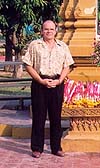




Course description
A step by step approach on how to gather information on current events and stories and be able to write opinions and express personal points of view. (Course was taught from June - September 2004)
Instructor: Ajarn Willard Van De Bogart - TESOL Certificate May 2003-SIT
The History of the course which prompted its developement at Nakhon Sawan Rajabhat University:
Click here to see student opinions of the course from a questionaire
Click here to see student's final papers
Additional Course work, Theory and Methodologies:

"Computers and the Internet are now an integral part of everyday life. Machines are increasingly replacing the human workforce. Young people must be prepared for utilizing new technologies, and their consequences."
Introduction:
Ajarn Willard Van De Bogart - Click on image for larger view.
The goal of this on-line course is to help Thai students develop their own ideas and points of view on social issues and everyday problems and situations through the process of reading, writing and internet search strategies.
Examples of stories will be shown by providing links to other sources on the internet, as well as access to a loose leaf binder of collected news articles organized in categories and a supplemental classroom book that complements the on-line chapters. The loose leaf binder has been designed to help Thai students organize their own ideas.
Each chapter of the on-line course, both on the internet and in the classroom text, has been designed to help Thai students organize their material and to be able to take notes and write opinions and points of view.
Students will be quided on how to get information as well as analyzing the information from various sources.
Independent portfolios will be required so students will have a reference for later use in their career.
Sources which will be coverd on-line with the internet:
Newspapers - Learning with the Bangkok Post
Magazines
Journals
Internet search strategies with Google, Noodle, and A9.
Interviews
Political Cartoons
Related links: At the end of the course students will be required to pass in a portfolio of their own opinions and points-of-view which they have prepared over the course of the semester as well as a final paper of 500 words. An explanation of the content of the portfolio will be discussed on the first day of class. Introduce Portfolio Plan For Your Portfolio Mid-Term portfolio requirements are listed in Chapter 5 Related link: Chapter one: Finding sources and getting ideas for your story. Chapter ten: How to express your ideas in writing - Draft I

Collect and Store all your Portfolio Items Carefully
Determine the best method of storage (or combination thereof) for the material you plan to include in your portfolio. Since you will collect items over an extended period of time, use binders, boxes, clipboards, or plastic containers with lids, as appropriate for each set of materials. Label each item to make it easy to find when it comes time to assemble your portfolio. While the term portfolio suggests a singular presentation, a comprehensive teaching portfolio will probably actually require several storage vessels.
Write a short introductory for your portfolio. Be sure to include a table of contents that allows readers to find materials quickly and easily.
Think of the story or stories you will be covering and plan to organize materials that relate to the stories in your portfolio.Developing Ideas and Expressing Opinions:
Chapter two: How to gather information
Chapter three: How to take notes
Chapter four: How to organize your story
Chapter five: How to write your story - Getting ready to write
Chapter six: How to use verbs effectively
Chapter seven: How to use nouns effectively
Chapter eight: How to write a point-of-view
Chapter nine: How to write an opinion
Begin to write Draft I, and prepare your final paper
Chapter eleven: Using the Internet - Boolean Search Strategies to help support your opinions - Return Draft I corrected
Chapter twelve: How to find libraries - Finding references to support your opinions - Final paper due Sept 30th
Chapter thirteen: Final Paper - Notes and Requirements
Return to: | Other writings by Willard Van De Bogart |